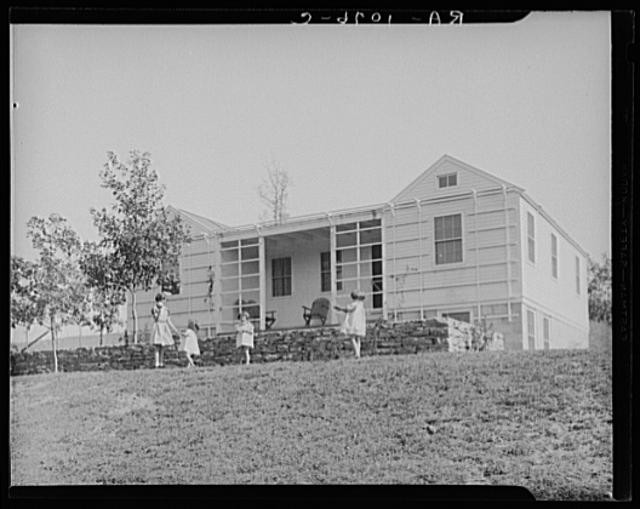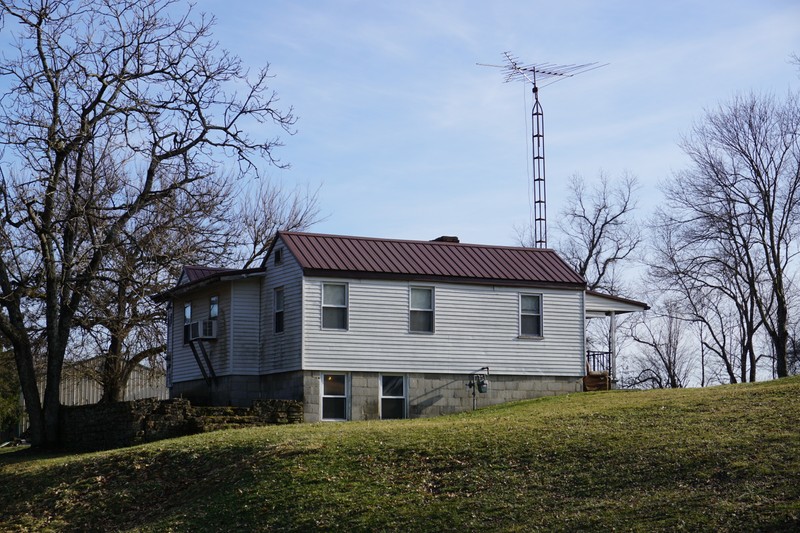A-3 Brotherton Hodgson House*
Introduction
Text-to-speech Audio
You'll notice to the right up on the hill, the Hodgson house where the Ambrose and Bessie Brotherton family once lived. It has a retaining wall which also functions as a small patio for the house. Additions like these were common to repair the Hodgson houses and to make their foundations more structurally sound in the 1930s. These needed repairs were expensive and wide-ranging and were a major reason why the government decided to build sturdier houses like the Wagner and Stone ones after the first 50 Hodgsons.
Images
A-3 Brotherton Hodgson House

A-3 Today

Backstory and Context
Text-to-speech Audio
The first houses in Arthurdale were known as Hodgson houses, manufactured by the E.F. Hodgson Company of Massachusetts. These were kit houses, part of a trend begun by Montgomery Ward & Co. and Sears, Roebuck & Co. in the late 19th century. E.F. Hodgson began his company in 1891 but began producing houses around 1900 when he saw the market appeal of summer vacation houses. He designed two versions of this house: the Hodgson Camp Cottage and the Hodgson Summer Cottage, which was also marketed as a Cape Cod House.
In the Hodgson House Catalogs produced between 1935-1939, Hodgson Houses are shown in various settings, including near “lakes, shores, mountains, northern snows, and tropical hurricanes” as an advertisement for their sturdy construction (Tedesco viii).
In 1933, the Division of Subsistence Homesteads purchased 50 Hodgson Houses for Arthurdale homesteaders. FDR’s advisor, Louis Howe, wanted to use these prefabricated homes because they could be constructed quickly, though Mrs. Roosevelt disagreed with the choice of uninsulated Hodgson Houses and characterized the decision as “absurd” (Hoffman 42). Howe ordered the houses despite this protest, and the problems with these houses created the first widely-publicized fiasco of the Arthurdale project as the press was attuned to any problems with this expensive, experimental community. The houses were unable to withstand winter in the Appalachian mountains and did not fit the foundations that had been laid for them. Homesteaders were frustrated by the building delay, and the cost of renovations to make the houses liveable was heavily criticized both by the national press and within FDR’s administration. The first homesteaders eventually moved into their new homes in July 1934.
Sources
Arthurdale Heritage, Preserving Arthurdale, WV – Eleanor Roosevelt's New Deal Community. Arthurdale Heritage Inc.. Accessed March 20, 2017. http://www.arthurdaleheritage.org/.
Axelrod, Alan. The Colonial Revival in America. W.W. Norton & Company, 1985.
Haid, Stephen Edward. "Arthurdale: An Experiment in Community Planning, 1933-1947." Master's thesis, West Virginia University, 1975.
Hoffman, Nancy. Eleanor Roosevelt and the Arthurdale Experiment. Linnet Books, 2001.
Maloney, C. J. Back to the Land: Arthurdale, FDRs New Deal, and the Costs of Economic Planning. John Wiley & Sons, 2013.
Patterson, Stuart. “A New Pattern of Life: The Public Past and Present of Two New Deal Communities.” Doctoral Thesis, Emory University, 2006.
Penix, Amanda Griffith. Images of America: Arthurdale. Arcadia Publishing, 2007.
Tedesco, Paul & James Tedesco. Portable and Prefabricated Houses of the Thirties: The E.F. Hodgson Company 1935 and 1939 Catalogs: An Unabridged Reprint. JBT Publishing, 2007.
Ward, Bryan. A New Deal for America. Arthurdale Heritage Inc., 1995
